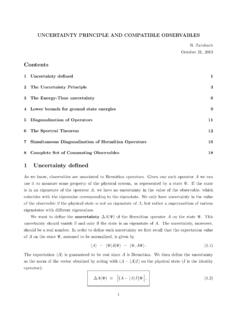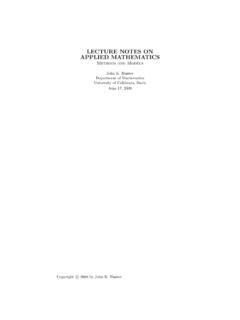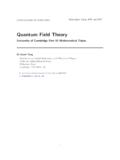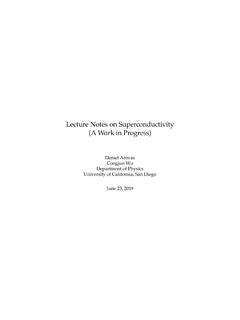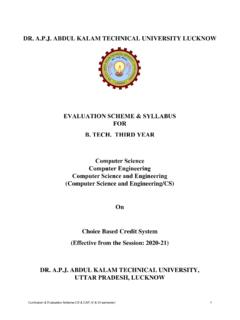Transcription of Chapter 1 INTRODUCTION TO NMR SPECTROSCOPY
1 Chapter 1. INTRODUCTION TO NMR SPECTROSCOPY . INTRODUCTION Nuclear magnetic resonance (NMR) is a spec- troscopic technique that detects the energy ab- sorbed by changes in the nuclear spin state. The application of NMR SPECTROSCOPY to the study of proteins and nucleic acids has provided unique in- formation on the dynamics and chemical kinetics of these systems. One important feature of NMR. is that it provides information, at the atomic level, on the dynamics of proteins and nucleic acids over an exceptionally wide range of time scales, ranging from seconds to pico-seconds. In addition, NMR. can also provide atomic level structural informa- tion of proteins and nucleic acids in solution (see Fig. ), there is no need to crystallize the sample for NMR studies.
2 Thus NMR provides a method of obtaining structural information if the Figure Protein struc- molecule cannot be crystallized or there is some ture determined by NMR. question regarding a structure obtained by X-ray SPECTROSCOPY . Four struc- crystallography. Lastly, it is relatively easy to tures of a 130 residue pro- study protein-ligand interactions under physiologi- tein, derived from NMR. cal conditions by simply adding ligand to the NMR constraints, are overlaid to sample of the unliganded protein. highlight the accuracy of Although NMR is a powerful technique, it does structure determination by have its limitations. First, almost all experiments NMR SPECTROSCOPY . require that the observed NMR absorption peaks are assigned to a particular atom in the protein.
3 Although resonance assign- ment methods are well characterized, they do require considerable time for data acquisition and analysis. Secondly, the size of the protein or nucleic acid that can be studied by NMR is limited. Assemblies with rotational correlation time of greater than 25 ns (corresponding to a protein with a molecular weight of 60 kDa) may be di cult to study at the detailed atomic level. However, more limited NMR studies can be performed on much larger proteins and biological assemblies. Generally, it is necessary to label larger proteins with 13 C, 15 N, and perhaps 2 H, to successfully apply NMR techniques to such large systems. 2 INTRODUCTION to NMR SPECTROSCOPY Labeling of this type is most easily accomplished biosynthetically in either E.
4 Coli or in tissue culture (at a much higher expense). A rough indication of the isotopic labeling requirements as a function of protein size is given in Table Lastly, due to the small energy di erence between the ground and excited state of the nuclear spins, NMR is a particularly insensitive technique. Protein concentrations on the order of to 1 mM are typical, thus a single ml NMR sample of a 20 kDa protein would require between 4 and 8 mg of protein. Fortunately, the techniques are not destructive and the sample can be used for other purposes. For most of this text we will employ a semi-classical model of the nuclear spins to obtain an intuitive understanding of many of the fundamental aspects of modern NMR SPECTROSCOPY . In this Chapter we will highlight a number of important features of NMR SPECTROSCOPY , including: 1.
5 How energy states are created by the magnetic field, 2. The relationship between the environment and the absorption energy, 3. Coupling between nuclear spins. Classical Description of NMR SPECTROSCOPY The basic phenomenon of nuclear magnetic resonance NMR SPECTROSCOPY is similar to other forms of SPECTROSCOPY , such as visible SPECTROSCOPY . A photon of light causes a transition from the ground state to the excited state. For example, in the case of visible SPECTROSCOPY the absorption of a photon by an electron causes the electron to move from its ground state orbital to an orbital of higher energy, the excited state. In the case of NMR, the absorption of a radio-frequency photon promotes a nuclear spin from its ground state to its excited state.
6 NMR SPECTROSCOPY di ers in a number of important aspects from other forms of SPECTROSCOPY . First, the generation of the ground and excited NMR states requires the existence of an external magnetic field. This requirement is a very important distinction of NMR SPECTROSCOPY in that it allows one to change the characteristic frequencies of the transitions by simply changing the applied magnetic field strength. Second, the NMR excited state has a lifetime that is on the order of 109 times longer than the lifetime of the excited electronic states. This di erence in lifetimes follows directly from Einstein's law for spontaneous emission that relates the lifetime of the excited state, , to the frequency of the Table Molecular Weight Limitations for Chemical Shift Assignments Isotopic Labeling Mol.
7 Weight None 10 kDa 15. N 10-15 kDa 15. N, 13 C 15-30 kDa 15. N, 13 C, 2 H 30-60 kDa 3. transition, : 1. ( ). 3. The long lifetime of the excited state implies extremely narrow spectral lines since the ability to define the energy of a transition is proportional to the life- time of the excited state 1 . In the case of small organic molecules, linewidths less than 1 Hz are easily attainable. Thus it is possible to detect small changes in absorption energies that arise from subtle di erences in the environment of a nuclear spin. The persistence of the excited state also facilitates multi- dimensional SPECTROSCOPY , by allowing the resonance frequency information as- sociated with one spin to be passed to another. Finally, the long lifetime of the excited state permits the measurement of molecular dynamics over a wide range of time scales.
8 Nuclear Spin Transitions In all forms of SPECTROSCOPY it is necessary to have two or more di erent states of the system that di er in energy. In a system with two energy levels, the one of lower energy if often referred to as the ground state and the higher energy state is the excited state. In the case of nuclear magnetic resonance SPECTROSCOPY , the energies of the states arise from the interaction of a nuclear magnetic dipole moment with an intense external magnetic field. Excitation of transitions between these states is stimulated using radio-frequency (RF). electromagnetic radiation. Magnetic Dipole The nuclear magnetic dipole moment arises from the spin angular momentum of the nucleus. All nuclei with an odd mass number ( 1 H, 13 C, 15 N) have spin angular momentum because they have an unpaired proton.
9 All nuclei with an even mass number and an odd charge ( 2 H, 14 N) also have spin angular momentum. The spin angular momentum, S, is quantized (as is all angular momentum). and the di erent quantum states are indexed with the spin quantum number = h I(I + 1). We ! I. The total angular momentum of a nuclear spin is: S. will generally be interested in the z-component of the angular moment, Sz , which is restricted to integral steps of h ranging from I to +I. For example, a spin one-half nuclei would have two possible values of Sz : + 21 h , and 12 h , corresponding to spin quantum numbers mz = + 21 and mz = 21 , respectively. The magnetic moment of a nuclear spin, , is proportional to its spin angular momentum, h I by a factor, , which has units of radians sec 1 gauss 1.
10 N = n h I . ( ). The magnitude of depends on the type of nuclei. NMR properties of various 1 This is one form of Heisenberg's uncertainty principle: E t h /2. 4 INTRODUCTION to NMR SPECTROSCOPY Table Properties of NMR Active Nuclei. Nuclei1 (rad sec 1 gauss 1 ) I Natural Abundance (%). 1. H 26,753 1/2 2. H 4,106 1 19. F 25,179 1/2 13. C 6,728 1/2 15. N -2,712 1/2 31. P 10,841 1/2 1. The term Protons is used interchangeably with 1 H in the text. 2. Fluorine is not normally found in biopolymers, therefore it has to be intro- duced by chemical or biosynthetic labeling. 3. These isotopes of carbon and nitrogen are normally found in low levels in biopolymers, therefore the levels of these two spins are generally enriched, of- ten to 100%, by biosynthetic labeling.
